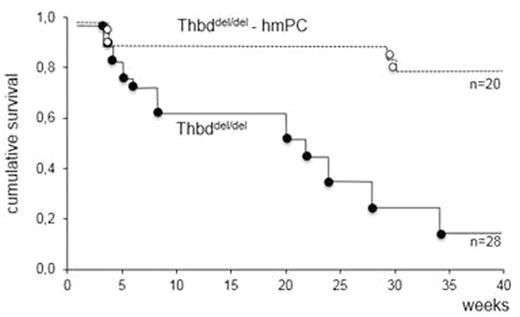Abstract
BACKGROUND AND APPROACH:
Thrombomodulin (Thbd) is a multifunctional transmembrane molecule expressed on endothelial, hematopoietic, placental trophoblast, and various other cells. Thbd facilitates protein C and TAFI activation by thrombin, but also exerts thrombin- and protein C-independent functions to regulate complement activity and inflammatory signaling. Complete Thbd deficiency causes embryonic death through as yet unclear mechanisms, while ablation of the lectin-like Thbd domain, reduction of Thbd cofactor activity for protein C (pC) activation, or truncation of the cytoplasmic domain do not impair embryonic development1-3. Here we applied in vivo structure-function and genetic complementation analyses to differentiate between pC-dependent and -independent Thbd functions.
RESULTS:
Three mouse strains with various function-selective Thbd mutations were generated, i.e. ThbdPro/ΔCS, ThbdEGF4-6, and ThbdLT (Table 1). Of these, only the latter mutant with defective thrombin-binding reproduced the embryonic lethal phenotype of complete Thbd deficiency. To examine the developmental role of Thbd expression in cell types other than placental trophoblast, Thbd LoxP mice carrying a conditional Thbd allele were crossed with mice expressing Cre recombinase under control of the endogenous Meox2 gene promotor, resulting in selective ablation of Thbd in the embryo proper, but preservation in extra-embryonic placental tissue. This yielded a normal number of Thbd-deficient embryos at term pregnancy. Preservation of Thbd function in the embryonic placenta therefore was sufficient to prevent intrauterine lethality until birth. Immunohistochemistry of term embryos and adult mice (week 10-16) confirmed persistent absence of Thbd expression. Half of Thbd-null mice were lost prior to weaning (3 weeks). Surviving mice were smaller, yet exhibited normal weight gain thereafter. By 4 weeks of age, 19 of 28 Thbd-deficient animals developed grossly observable lesions, i.e. purple discoloration and swelling of tail segments, followed by, edematic swelling and discoloration of the tail and hind limb digits, distal tail necrosis and/or uni- or bilateral eye degeneration. More than half of the Thbd-null mice expired within the first 10 weeks of life, and only 2 of 28 mice survived to week 40. Neither gross anatomical inspection nor histological surveys of internal organs revealed evidence of severe thrombotic organ damage, and except for elevated IL-6, cytokine plasma levels were normal. Tamoxifen-induced Thbd LoxP gene ablation in adult mice (10-12 week old) reproduced the phenotype of Meox2Cre-Thbd-null mice. Genetic supplementation of activated PC by transgenic expression of a partially Thbd-independent murine pC zymogen variant (“hyperactivatable” protein C4), prevented perinatal lethality, partially restored normal birth weight, and largely prevented the phenotype of Thbd-null mice. However, Thbd-null females expressing the pC transgene exhibited pregnancy-induced morbidity and mortality with complete penetrance. When mated to wild type males (embryonic placenta expresses Thbd), 8 of 8 pregnancies ended in death or severe distress during gestation or postpartum.
CONCLUSIONS:
These findings indicate that the lack of protein C activation by Thbd-bound thrombin is the sole cause of lethality of embryonic and adult Thbd-null mice; and that Thbd expression in extra-embryonic placental tissue is sufficient to prevent intra-uterine lethality. The mortality of pregnant Thbd-null females expressing the protein C transgene constitutes a novel model for pregnancy-specific complications associated with defects in the function of natural anticoagulant pathways.
REFERENCES:
1. Isermann B et al. Nat Med. 2003;9(3):331-337.
2. Conway EM et al. Blood. 1999;93(10):3442-3450.
3. Conway EM et al. J Exp Med. 2002;196(5):565-577.
4. Isermann B et al. Nat Med. 2007;13(11):1349-1358.
Survival of Thbd-null mice with and without the hyperactivatable PC transgene (hmPC).
Survival of Thbd-null mice with and without the hyperactivatable PC transgene (hmPC).
No relevant conflicts of interest to declare.
Author notes
Asterisk with author names denotes non-ASH members.



This feature is available to Subscribers Only
Sign In or Create an Account Close Modal